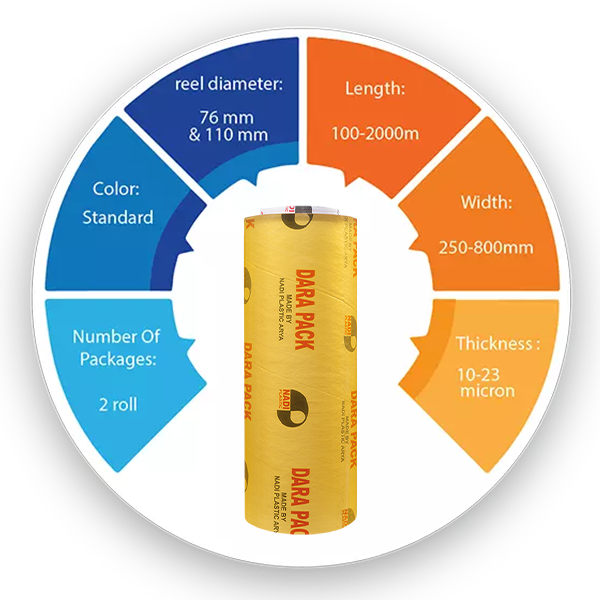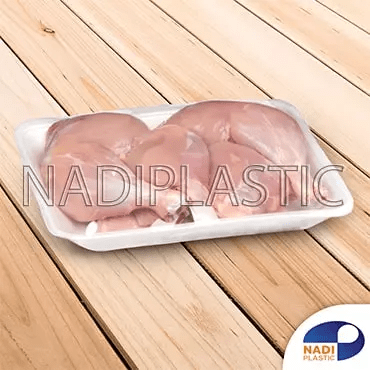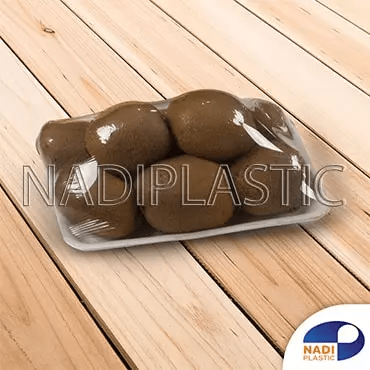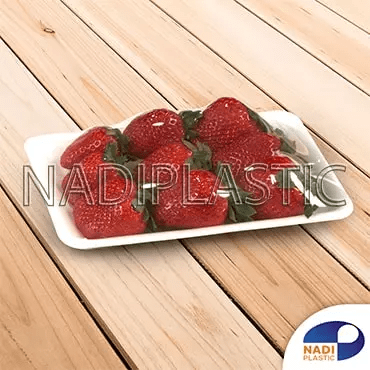PVC Cling films are the perfect solution for packaging food products. Cling films preserve the freshness of your product. They also have a clear glossiness which showcases the product better than any other form of packaging. NadiPack is the biggest manufacturer of PVC cling film in Iran and uses Korean material to create the highest quality cling rolls at a very affordable price. You can use these films manually or use them through automatic machines for the optimum result. For ordering PVC Cling films or inquiries about the latest prices, contact us at +982188779366.


Introducing NadiPlastic’s PVC Cling Films
NadiPlastic’s PVC cling rolls are competing with the biggest names in terms of quality at a much more affordable price range. Our material comes equipped with the latest health and environmental standards to make sure your product is fresh and sustainable.
PVC cling films preserve fresh products by regulating the amount of moisture and oxygen necessary in the packaging. They are also odorless.
So, the product quality will not change or drop over time. Cling films also have an anti-fog property which is perfect for food products containing moisture.
PVC has a clear and glossy look and clings very well. This helps with the appearance of your product and helps it through transportation and shelf life.
What is PVC Cling Film?
PVC cling film is a thin layer of plastic that is used to cover food products amongst other things. They are known as Saran wrap or plastic wrap in the domestic market and are sold as PVC cling rolls for industrial use. The cling quality makes them a reliable packaging component and their clear appearance means your product’s look is maintained all the way through. They are also popular in the food industry as they don’t isolate the food inside the packaging. Today’s PVC cling films are also odorless. All of this means foods in cling wrap have a longer shelf life than some other forms of packaging.
Unlike PVC shrink films that need heat for application, cling films can be used manually. There are also fully automatic machines that can handle the process of packaging in high volume. Cling films come in two forms of PVC cling wrap and PE cling wrap. Although PVC is much more popular as it clings better and can be used with 95% of food products. PE clings are specifically good for packaging high-fat products such as butter, cheese and fish.
Facts about PVC Cling Films
- Cling films were discovered first by Ralph Wiley as a result of an accident.
- Cling films were first used as a safety measure on airplanes' body-surface through the First World war.
- Cling wraps were first released as a commercial product under the brand Saran Wrap.
- Many scientists used to assume static electricity is making cling wrap cling. But today they understand it is the result of PVC’s strong molecular bond and its spring-like formation.
- Odorless for preserving the product’s quality
- Oxygen and moisture regulation for longer shelf life
- Clear and glossy appearance
- In accordance with the Latest health and safety standards
- Korean material
- Usable manually or through automatic machines
- Fog resistant
What is PVC shrink film?
Stretch PVC film is a thin transparent plastic layer that is usually used for packaging food. These films are anti-steam and they prevent from the surface of the package being opaque as a result of drops created by the food in the package. Stretch PVC films are produced with the highest sanitary standards; as a result, we can package the food products using them with peace of mind.
Since stretch PVD is odorless and does not change the product’s quality, the products packaged using this method enjoy a longer life. This type of packaging allows oxygen and humidity to move around and they prevent the entrance of aerosol at the same time.
Contrary to the PVC shrink films that require heat for packaging, it is possible to use Korean food stretch for packaging only using your hands. This type of film can also be used along with automatic devices. The stretch films are supplied in two major groups of PVC and Polyethylene (PE), where the PVC materials are more popular due to greater adhesion and higher sanitary standards. The details of Korean stretch film are produced and supplied by Nadi Plastics, which is explained in the following.
Information and features of food stretch
- It was invented accidentally by Ralph and Wiley in 1933.
- At first, it was used as a spray and to strengthen the planes against sea salt in the Second World War.
- It was first supplied in 1953 under the name of Saran to the home appliance market, and it is still known by the same name in many parts of the world.
- Scientists first believed that static electricity makes stretch stick to objects. However, now, scientists believe that these films stick to objects due to firm molecular bonds between the PVC and its springy structure.
What are Cling Film Advantages?
Cling films are used widely in the food industry. This is due to the many advantages these films have to offer. PVC cling films especially have high durability, which is key in packaging efficiency and food transportation. But the biggest advantage of cling film lies in its preservative qualities. PVC lets oxygen and moisture flow through the packaging. This means your product can breathe. It also stops dust from entering the package. Cling films are aesthetically pleasing. Food products are at their best when the customer can see them directly. So, your customer can actually see how appetizing and fresh your product is. PVC films also have the same thickness all the way through which adds to their presentability. Today also PVC material used in cling films has improved greatly in terms of its healthiness and sustainability.
What is PVC shrink film?
Both PVC films and Polyethylene (PE) films feature good adhesive power, and they can change into any shape and size of food packaging. One of the problems of packaging films to package the materials without a certain and orderly shape is that they need to be heated. In order for it to stick to all surfaces of the goods, it is first heated to become softer, more pliable, and adhesive. There is nothing wrong with food stretch and the film needs no heating (using a hair drier…). For this reason, many companies and production sites prefer this type of film to package their products.
Use Cases of PVC Cling Rolls
PVC cling films (also known as plastic wrap) are a great choice for food packaging. Cling films let your product breathe whilst preserving it from dust and external odor. These films are also clear and put your product directly on display. You can use PVC cling films in packaging fruits, vegetables, frozen foods, meat, bread, confectionery, sandwiches and dry products.
Using PVC stretch film for frozen food
It is easy to store food stretch cover; you only need to keep it away from sunlight, humidity, and rain. The ideal temperature for keeping food stretch film is between 5 °C to 30 °C. Note that this temperature is the most favorable temperature range, and it does not mean that you can not use it at other temperatures.
The adjustment of package oxygen and humidity
Films of PVC stretch allow humidity and oxygen to pass through it adequately and prevent the penetration of aerosol into the product package. As a result, the product’s life gets longer, and its quality is preserved during the storage period.
Using hygienic raw materials in producing food stretch
The films of stretch are mostly used for packaging food; for this reason, the companies producing these films pay particular attention to hygiene factors and choose the materials used in producing films based on sanitary standards. Food stretch makes no chemical changes in the composition of the foodstuffs, and its composition does not create any threat to health in contact with foodstuffs.
The beautiful appearance of packaging film
one of the main goals of packaging all products, including food, industrial products, plastics, toys, etc., is to make their appearance attractive. The films of the PVC stretch are very transparent, and their thickness is the same throughout the body; as a result, applying them makes your goods look more beautiful. The goods that are packaged using PVC stretch film are very radiant under light, and they are also more transparent than other packages. Therefore, many producers prefer this package to cover their products to achieve higher radiation and transparency.
The costs of packaging using food stretch
The films of stretch packaging have a very reasonable price in addition to all the other many advantages it already has. Using this type of packaging film in high volumes is very economical for producers. In addition to the price of the product itself, considering that the necessities and required devices to do the packaging using good stretch costs less than other types of packaging, the costs of launching packaging sites using this packaging in the companies will be very low.
Purchasing stretch film and important points in the purchase
Choosing the correct packaging has a significant effect on preserving and increasing safety at the time of transportation. If you believe that there is no difference between most of the stretch films in the market in terms of efficiency, price, and composition of the materials making them, I should say that you are wrong! The basic composition used by companies producing and supplying these films is different. For example, Nadi Plastics supplies Korean stretch film with greater strength and transparency. For this reason, it is very important that you purchase a quality stretch film. In the following, some of the considerable key components will be pointed out to select the appropriate food stretch.
The layers of stretch film.
The number of stretch films of foodstuff plays a fundamental role in both the elasticity capacity and overall strength of your roll. Nowadays, most of the existing elastic films are made up of five layers, but some new technologies have managed to produce stretch films containing up to 55 layers. The most important item in mechanical packaging film is the advanced technology of extrusion because of being highly efficient and economical.
Recyclable nature of the film
Over the past years, a major part of the producers of food stretch has concentrated on producing elastic films containing a higher amount of recyclable content. However, many of them still refuse to produce environment-friendly films. These products keep materials sufficiently safe and sound while consuming less carbon to produce them. The advancement of knowledge has provided us with the means to provide durable food stretch containing recyclable materials to the market using green technology (environment friendly). The main difference between recyclable stretch film is the composition of the materials comprising it (51% plant resins, 30% recyclable polymer contents, and 19% virgin polymer), carbon-free production, and reliable and flawless performance level.
Therefore, the consumers of these films will not worry about the destruction of the environment and can supply their products to the market with peace of mind using the packages made of these materials.
The packaged goods
To select an appropriate food stretch, we should pay close attention to the type of packaged and supplied goods, packaging method, storage, and transportation of the goods. For example, you need food stretch to package the food or elastic films with relatively less thickness. However, to package the furniture, cartoon, pallets, etc., and also to make the untidy and unbalanced loads, we will definitely need a more resistant and more durable thick food stretch film.
Therefore, you should pay attention to the goods you are about to buy as well as paying attention to the features of the film itself so that you can purchase a film that is appropriate for the film you use.
Different types of mechanical food stretch are:
Stretch is produced and supplied to the market in different sizes, dimensions, and thicknesses. In the following, a list of different types of this type of plastic film is provided, and the features, capabilities, materials used, and quality of each of them are examined in what follows.
Mechanical stretch film
Different types of mechanical food stretch are Cast stretch, blown stretch, pre-stretch, and Hay bailing stretch. Each of these films is used for a particular purpose.
Non-mechanical stretch
Different types of this film are Hand stretch, color stretch, UVI, VCI, vented stretch, reinforced stretch, and no cling stretch.
What is a mechanical stretch?
The mechanical stretch film is used by the stretch wrapping machine. One of the advantages of this film is its high safety, greater binding, lower costs of materials, and quick and high efficiency of packaging. We examine different types of mechanical stretch in what follows.
Blown stretch
This film expands near its rupture point before it wraps around the rolls. We do not need much energy to make the pre-stretch film reach the packaging force. Also, using this mechanical film leads to a considerable reduction in costs.
Pre-stretch
Different types of this film are Hand stretch, color stretch, UVI, VCI, vented stretch, reinforced stretch, and no cling stretch.
Cast stretch
The cast stretch will be made through an extrusion casting operation. This film features high transparency and allows the users to see the products inside the packaging easily. The cast stretch features high elasticity and can be stretched easily. Cast stretch film is adhesive on both sides, which makes it easy to wrap this film around the package. Firm packaging of products facilitates transportation.
One of the advantages of cast stretch is that it is economical. However, this film does not perform well as far as a rupture is concerned and enjoys a high tensile property.
Hay Baling stretch
Hay bailing stretch is a multi-layered tensile film that is mainly used in the field of agriculture. In many types of these covers, LDPE formulation and the shortage of oxygen are used to keep agricultural crops dry. Hay bailing stretch is also known as tensile cover of silage.
Non-mechanical stretch
Color Stretch
Color stretch films have been created for uses requiring specialized packaging, and other types of stretch films cannot do this. Color stretch films are highly resistant to rupture and piercing. These films are used to code warehouse color, stock, and international transfers.
Vented stretch
Vented stretch is a very good option in cases where the products inside the packaging have to come into contact with air and oxygen. For example, packaging bakery items, wooden pallets… It is done using this type of film.
Reinforced stretch
The strong formulation and high thickness of the reinforced stretch have turned it into an ideal option for packaging and protecting heavy items when being transported, like making pallets of bricks and building blocks.
VCI stretch
The formulation used in making VCI stretch films prevents oxidation and rusting of metals. This tensile film is used for packaging all metal items and products.
No Cling stretch
No cling stretch film is used for packaging some products like carpets to prevent them from being entangled with each other and rupturing.
The method of packaging with PVC stretch
You are reminded that food stretch film can also be wrapped around the goods using hands or machinery. Also, some semi-automatic devices (with the help of a force) have been designed and produced specifically for this purpose which facilitates packaging.
In packaging using hands, one of the workforces alone should wrap the film around the box, pallet or goods and cut the tape at the end and stick it to the package. This type of packaging has a lower speed than the method where automatic and semi-automatic machines are used.






